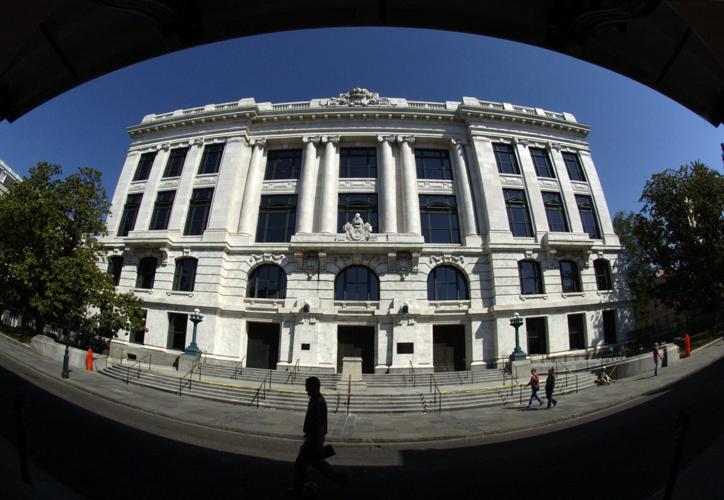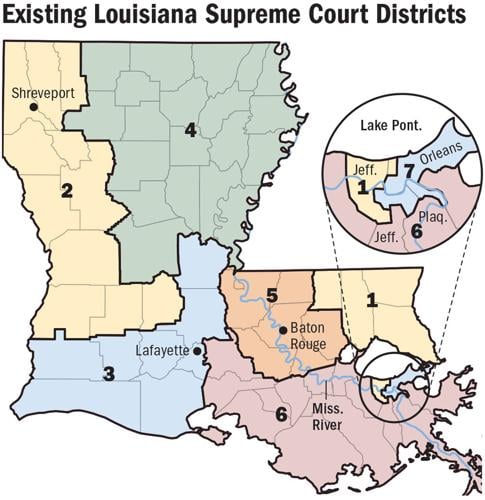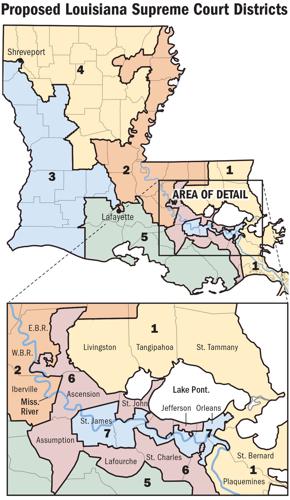Gov.-elect Jeff Landry and a majority of the Louisiana Supreme Court are pushing to have state legislators redraw the court’s boundaries during an upcoming special session by approving a plan that, while not yet widely known, has already proven controversial.
Only a few political insiders have seen the proposed redesign, which would dramatically alter the court’s existing shape in order to create a second Black-majority district, end wide population disparities among the districts and enhance the conservative advantage on the seven-member court.
In an interview, Landry said he wants state legislators to take up the court reapportionment plan when they meet in a special session that he is planning to call for Jan. 15-23. The governor-elect, who takes office on Monday, had already said he wants legislators to reshape the state’s six congressional districts during that session to add a second Black-majority congressional seat.
A U.S. Supreme Court ruling involving redistricting in Alabama is forcing the governor-elect’s hand with the congressional map in Louisiana. Supporters of the proposed reapportionment of the state Supreme Court say the Alabama decision could lead U.S. District Court Judge John deGravelles in Baton Rouge to demand new lines for the Supreme Court seats as well.
William Crain, an associate justice of the Louisiana Supreme Court who others have identified as the prime mover behind the proposed new map, said in an interview that he and Justice Jay McCallum met with Landry to receive his blessing for political and legal reasons.
“You know what a good map is? One that can pass,” Crain said, noting that justices and lawmakers have failed for 25 years to redistrict the Supreme Court’s boundaries. “My reading of the tea leaves is if the governor does not support the map, it cannot pass,” Crain said. “If he does support the map, it can pass.”
Crain noted that Landry knows the issue well because the outgoing attorney general has opposed a lawsuit, filed by the NAACP in 2019 and now before deGravelles, that seeks to declare the current districts unconstitutional because they are designed to elect only one African American justice.
“I want out from underneath the litigation,” Landry said, noting that most members of the Supreme Court support the new plan. “The court has come to a consensus, and I respect it.”
Redistricting fight
The redistricting fight has laid bare politicking behind the scenes by Supreme Court members who are elected in Louisiana but dismiss suggestions that they are politicians.
Joining Crain and McCallum in supporting the plan is one other Republican justice (Jefferson Hughes), one independent (James Genovese) and the only Democrat on the court (Piper Griffin).
The other two court members have criticized the plan, with Chief Justice John Weimer writing in a letter that he was told it was "designed to protect three justices who face re-election."
Those justices are Crain, McCallum and Griffin. Weimer and the other three justices cannot run for reelection when their current 10-year terms end. No justice over 70 can run again.
Justice Scott Crichton, who along with Weimer, Hughes and Genovese cannot seek reelection, opposes the new map because it would eviscerate his Shreveport-based district.
Crichton’s seat is up for grabs this year, which is why the Supreme Court has a rare “window of opportunity” to have state legislators redraw their lines now, Crain said.
Crain said that past efforts to reconfigure the court boundaries have foundered because no one could produce a redrawn map that did not force one incumbent to run against another. He said that the current proposal works because only three incumbents are planning to run for reelection.
“What we have done is historic,” said Crain. “We have delivered to the Legislature a map that creates a second Black district with a voting age population that meets the current legal criteria. We have balanced all the districts’ population within plus or minus 5%. We made sure that we did not draw a district that would have required two sitting Supreme Court justices to run against each other.”
Achieving all this, Crain said, “was a heavy, heavy lift.”
But Weimer, who supports creating a second Black-majority district, said the proposed plan “was created with a complete lack of transparency.”
“There is plenty of time,” Weimer added, “to resolve the important issue of redistricting our state's highest court in a public, transparent, open, and measured manner during the regular session of the legislature, during which time everyone can be heard.”
McCallum rejected that argument, saying they need to act in January given the case before deGravelles.
“If a train is bearing down on you, why wouldn’t you get out of the way?” he asked.
Qualifying for Crichton’s seat is not until July.
Who could run for the seat?
Jeff Cox, an appeals court judge in Shreveport, has been positioning himself to run under the current boundaries.
But under the proposed map supported by the five justices, Crichton’s district would shift to the east and become the second Black-majority district. With a Black voting population of 55%, it would run from the northeast corner of Louisiana down along the Mississippi River and be anchored in East Baton Rouge Parish.
John Michael Guidry, the chief judge of the 1st Circuit Court of Appeal in Baton Rouge, said he would run for the seat if it’s approved by state legislators.
Guidry, an African American Democrat who was endorsed by the Louisiana Association of Business and Industry, noted that he narrowly lost a 2012 Supreme Court race to Hughes in a district that heavily favored a White candidate.
Under the new boundaries, “I think the chances of my prevailing are greatly increased,” he said.
But a source familiar with the negotiations around the plan said the new districts were deliberately drawn to put south Baton Rouge, where Guidry ran strong 12 years ago, into another Supreme Court district. This was done to improve the chances of Tony Clayton, the district attorney in West Baton Rouge, Pointe Coupee and Iberville parishes, in case he decides to run.
“I’m happy doing what I’m doing,” Clayton said when asked about his plans, but he would not rule out entering the race.
Several political insiders believe that Landry wants the new map to create a winnable Supreme Court seat for Wilbur Stiles, his former chief deputy and now a judge on the 3rd Circuit Court of Appeal who lives in New Iberia.
Landry said he didn’t do anything to help Stiles and said his former aide has never expressed an interest in running for the Supreme Court. He said that several other current judges, including Jonathan Perry, a former state senator, have shown a desire to run.
Crain said that after he showed the map to Landry, the boundaries in Acadiana were adjusted, but Landry said this was done with north Lafayette precincts to strengthen the new Black majority district.
Stiles, who did not return phone calls, lives in the district now represented by Weimer, who can continue to hold the seat until he is termed out of office because of age in eight years. Weimer has enraged conservatives by consistently hewing an independent line.


Getting the map over the finish line
Several insiders said that Cade Cole, an attorney in Sulphur, handled the mechanics of redrawing the lines. Cole did not return a phone call.
Griffin would gain more than 100,000 new residents under the new map because her current district has a smaller population than the other Supreme Court districts. She said she supports the change because it would give her a Black-majority district similar to one proposed previously by the NAACP, and it creates a second one in the state.
To pass the new map requires hurdling a high bar, a two-thirds majority of 28 votes in the 39-member Senate and 70 votes in the 105-member House.
State Sen.-elect Alan Seabaugh, R-Shreveport, said he opposes the plan, calling it a “backroom deal” drawn by the justices and saying, “It’s impossible to draw a second district without gerrymandering.”
But state Sen. Patrick McMath, R-Covington, said that lawmakers ought to reconfigure the Supreme Court maps during the special session since they are already planning to redraw the congressional maps.
State Rep. Wilford Carter, D-Lake Charles, helped kill a plan two years ago to solve the redistricting dilemma by adding two seats to the Supreme Court that Black candidates could win but lock in a 6-3 conservative majority on the court.
He supports the latest plan, saying it would lead to a better court.
“Some people will be upset in some parts of the state, but we can get the votes to put it across,” Carter said.




